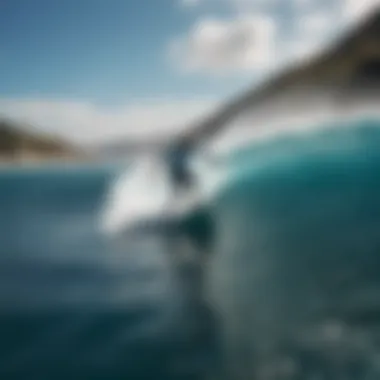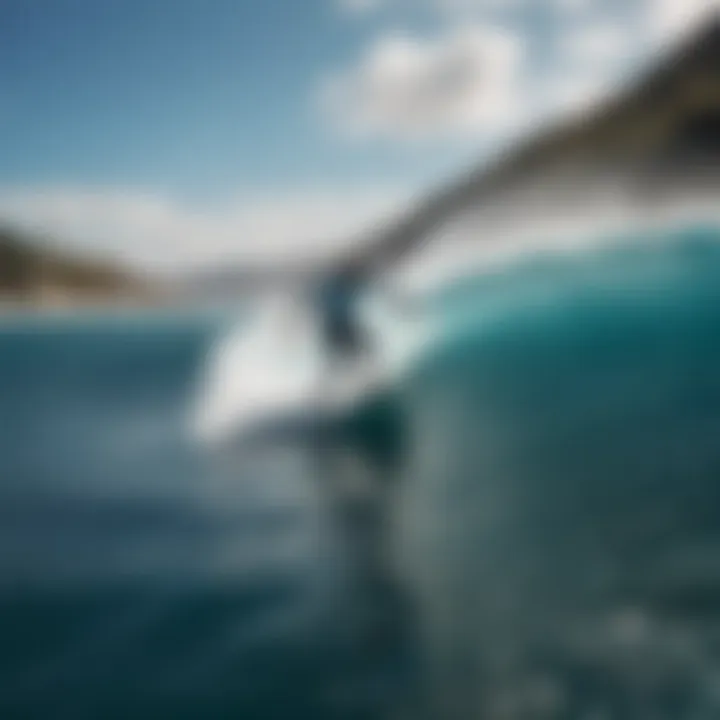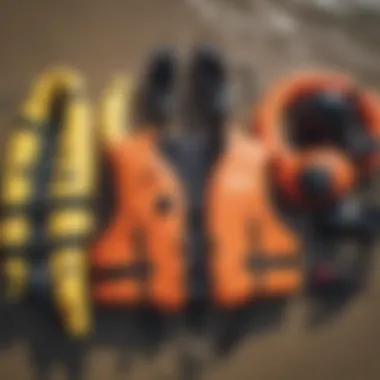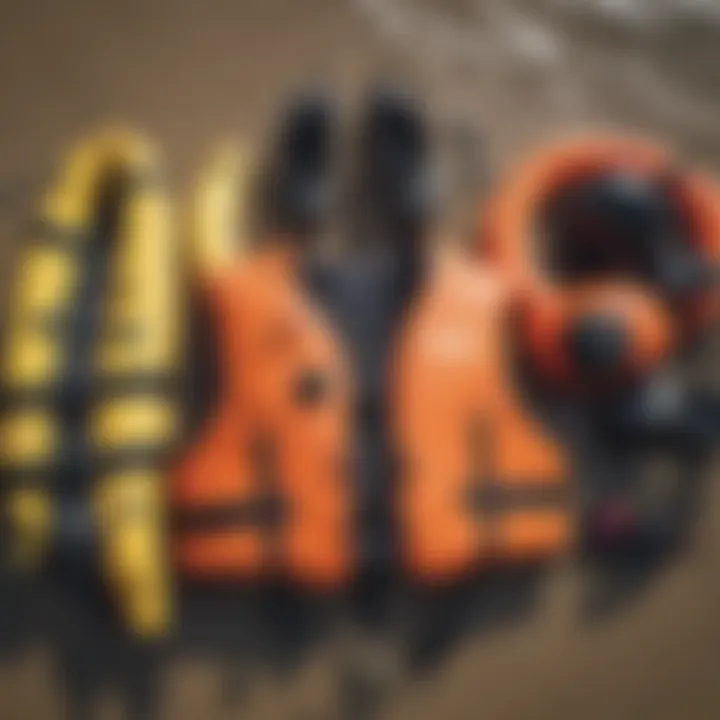Mastering the Art of Surfboarding Behind Boats


Intro
Surfboards behind boats present a unique thrill that blends the adrenaline rush of traditional surfing with the accessibility of being towed. Whether it's the gentle tug of the water or the splash of the waves, this experience brings together enthusiasts from different backgrounds. What draws people to this sport is not just the enjoyment but also the camaraderie it fosters. Families and friends gathered at the lake, sharing tips, and laughing as they take turns trying to ride that perfect wave.
In exploring this dynamic activity, a closer look at essential gear, useful techniques, and important safety measures is imperative. With many choices on the market, understanding what equipment works best will make all the difference in your time on the water. From beginners just finding their footing to experienced riders looking to hone their abilities, there’s something valuable here for everyone.
Gear Essentials
To elevate your experience and ensure safety while riding surfboards behind boats, having the right gear is key. The following sections break down what’s necessary.
Top Picks for Watersports Equipment
When it comes to equipment, you don't want to cut corners. Here are some standout items that cater to different skill levels:
- Surfboard: A thicker, wider board made specifically for being towed is ideal. Brands like Liquid Force and Hyperlite offer great options that improve buoyancy and stability.
- Tow Rope: A durable tow rope is essential. Look for one that’s at least 75 feet long and rated for your weight. Accurate Pro or Ronix make great choices.
- Life Jacket: Safety first! A comfortable, Coast Guard-approved life jacket that allows free movement is non-negotiable. Choose one that fits snugly but does not restrict your mobility.
- Bindings: Consider adjustable bindings that suit various foot sizes. This way, you can share your gear with friends or family without any hassle.
- Wetsuit: Depending on the water temperature, a wetsuit will keep you warm and offer modesty while ensuring freedom of movement.
Maintenance and Care Tips for Gear
Taking care of your equipment prolongs its life and ensures safety. Here are some maintenance tips that every watersport enthusiast should remember:
- Rinse Off: Always rinse your gear with fresh water after each session. Saltwater and sand can cause wear and tear over time.
- Inspect Regularly: Before use, check for any signs of damage, like frayed ropes or loose bindings. A small problem can quickly lead to bigger issues.
- Store Properly: Keep your surfboard in a cool, dry place to avoid warping. Use a board bag for added protection during transport.
- Dry Gear: Always allow your wetsuit and other fabric gear to air dry properly. Storing damp items can lead to mildew or unpleasant odors.
"Investing in good gear and maintaining it well can make all the difference when you're out on the water."
Techniques and Tips
To master the art of being towed behind the boat on a surfboard, it's not just about the equipment; it's about the techniques as well.
Beginner Tips for Each Watersport
If you're new to this sport, starting with some basic tips is beneficial. Here’s how you can find your feet:
- Start Slow: Begin with slow speeds. Gradually increase your speed as you gain confidence.
- Position Yourself Right: Keep your knees bent and lean slightly back on the board. This position helps maintain balance and control.
- Hold the Tow Rope: Hook the tow rope with both hands and keep your hands shoulder-width apart. This grip helps in keeping the board steady.
Advanced Techniques for Skill Enhancement
For those who have been at it for a while, refining your techniques will elevate your game. Consider these tips:
- Practice Starts: Work on the take-off. Getting up quickly can make a world of difference.
- Try Different Angles: Experiment with your stance as you get comfortable riding. Change the angle of the board to carve through the water more effectively.
- Learn Tricks: Once you're proficient, integrate small tricks like the 180 spin. Always practice in safe, open waters with supervision.
With time and practice, anyone can find joy in the dynamic world of surfboards behind boats. Understanding the mechanics, the equipment, and the skills required can help not only to enhance enjoyment but also create lasting memories on the water.
Preface to Surfboarding Behind Boats
Surfboarding behind boats blends the thrill of surfing with the dynamic environment of lakes and rivers, creating a unique opportunity for enthusiasts to enhance their skills and enjoyment. This sport, which connects watercraft and surf riding, is more than just a mere pastime; it embodies freedom and exhilaration. However, many newcomers and even seasoned riders may not fully grasp the nuances involved. Understanding these elements is crucial, as it builds a solid foundation for safe and enjoyable experiences on the water.
Definition and Concept
At its core, surfboarding behind boats refers to the act of riding a surfboard while being towed by a boat. This technique employs the boat's wake—the waves created by its movement—providing surfers with the perfect platform to ride. It's essential to note that this sport is distinct from traditional surfing. In many ways, it presents an accessible route for those who may not live near the ocean yet crave the rush of riding waves.
The simplicity of the concept belies its depth. Riders can tailor their experience based on a variety of factors including the boat’s speed, weight distribution, and the type of surfboard they choose. The ride’s dynamics hinge not only on the boat but also on water conditions and the rider’s ability to harness the wake effectively.
Origins and Evolution
The evolution of surfboarding behind boats can be traced back to the 1970s. Initially, it was a way for surfers to keep their skills sharp during the off-season. With time, this approach evolved as technology improved. The introduction of specialized boards and better towing equipment transformed the landscape of this sport.
As boat engines became more powerful, they enabled the creation of larger wakes, which in turn captivated more surfers. It didn't take long for the practice to gain popularity, and many enthusiasts began customizing their boards and techniques to suit various water conditions.
"The thrill of surfboarding behind a boat isn't just about catching waves; it's about carving your own path on the water, pushing the limits of what you thought was possible."
In recent years, the community has grown substantially, driven by social media and increased access to different bodies of water. Surfboarding behind boats has moved from being merely a niche hobby to a thriving part of the watersports culture, connecting like-minded adventurers and setting the stage for new innovations in gear and technique.
Both the origins and the evolution of this sport remind us that it is not merely an activity; it represents a lifestyle for many. This journey reflects a deeper appreciation for nature, a sense of community among enthusiasts, and an unyielding passion for adventure as they ride the wake.
Equipment Essentials
Understanding the essentials of the equipment needed for surfboarding behind boats is crucial for both safety and performance. The right gear can make a world of difference, whether you're just starting or looking to refine your skills. This section looks at the critical components, from choosing the right board to considering necessary safety accessories, ensuring a smooth ride on the water.
Choosing the Right Board
Types of Surfboards
When it comes to selecting a surfboard for being towed behind a boat, the type of board plays a significant role. There are various types—each suited for different riding styles and conditions. A popular choice is the wake surfboard, designed to perform well in the wake generated by a boat. The unique feature of wake surfboards is their shorter length and thicker outline, which allows for better buoyancy and maneuverability on the wake. They’re favorable for those looking to surf without the need for a high-speed tow.


However, it's key to note that not all boards are created equal. Longboards can offer a different experience, providing stability for novices, yet they may lack the quick response needed for advanced maneuvers. Choosing wisely can lead to an enjoyable experience on the water.
Size Considerations
Size is another critical factor. The length, width, and thickness of a surfboard contribute to its performance. A typical wake surfboard ranges from 4 to 6 feet. In general, larger boards provide extra buoyancy, making them easier for beginners to ride. Their larger surface area enhances floatation, allowing for a steadier ride behind the boat.
But there's a trade-off. Smaller boards might be less stable, yet they offer more agility for performing tricks. It’s essential to tailor your board size based on your skill level and performance goals. For instance, if you’re in the beginner phase, a longer and broader board can help build confidence as you get the hang of it.
Material Choices
Material also matters when considering surfboards. The most common materials include foam, fiberglass, and carbon fiber. Foam boards are durable and often less expensive, making them a great entry-level option. Their buoyancy factor is beneficial for novices learning to balance on the water.
On the other hand, fiberglass boards are stiffer and provide a more responsive ride. While they offer good performance, they can be heavy and less forgiving if a fall happens. Carbon fiber is top-of-the-line for pros searching for lightweight and super-resilient boards, but they come with a hefty price tag. Knowing the nuances of each material and its implications can significantly enhance your riding experience.
Boat Specifications
Power and Type of Boat
Not all boats are meant for towing surfers; the type and power of the boat make a big difference. Typically, inboard boats, especially those designed for water sports, are deemed superior due to their hull design and engine positioning. A good balance of power and efficiency can create the perfect wake for surfing. A boat with too little power can struggle at higher speeds, while an excessively powerful boat may result in harsh and choppy wake conditions.
Boats with towers can help elevate the tow line, allowing for a better pull and improved wave formation, which is vital for a smooth ride. However, the choice should also depend on the skill level of the rider—novices may want to start with more stable boats before venturing into advanced setups.
Towing Capacity
Towing capacity is a critical specification that must not be overlooked. Each boat comes with a towing capacity, which dictates how much weight it can safely pull. A boat’s towing capacity is influenced by its size and power. It is crucial to always stay within this limit to ensure safety.
While the thought of having multiple riders behind the boat might be tempting, exceeding the towing capacity can lead to accidents. Always refer to the manufacturer’s specifications and err on the side of caution; safety first, always.
Wake Formation
Wake formation is something that can often be underestimated by many. A well-defined wake is essential for an enjoyable ride behind the boat. Properly weighting the boat can help create a larger and more consistent wake, allowing for smoother surfing.
Factors like boat speed and ballast weight play pivotal roles in wake creation. For those looking to ride, speeds between 10 and 15 mph are often ideal for a pleasant experience. Understanding how to manipulate these elements can make a huge difference, especially when transitioning between beginner and advanced levels of surfing.
Safety Gear and Accessories
Personal Flotation Devices
The importance of personal flotation devices (PFDs) cannot be overstated in this sport. All riders should wear a properly fitted PFD at all times while being towed behind a boat. Not only is it a legal requirement in many areas, but it also provides crucial safety in case of a fall or unexpected incident in the water. PFDs have evolved to be more than just safety items; they now come in a variety of styles and sizes suited for diverse tastes and needs.
The unique feature of modern PFDs is their buoyancy, which keeps you afloat while allowing the freedom of movement required to enjoy surfing. Some are designed with built-in support for active sports, ensuring security while riding the waves.
Wetsuits and Impact Vests
When adventuring into cooler waters, wetsuits become imperative. They not only offer thermal insulation but also protect against abrasions and impact. An impact vest can complement the wetsuit, providing additional cushioning for those inevitable falls.
Wetsuits, typically made from neoprene, are designed to trap a thin layer of water next to the skin, which warms up from body heat, thus keeping you comfortable while you surf. This is especially important in colder conditions where feeling decent can be a game-changer. However, opting for both can feel restrictive; hence selecting the proper fit is essential.
Optional Accessories
Lastly, while optional accessories might seem trivial at first glance, they can enhance the overall surfboarding experience. Items like surfboard leashes ensure that your board stays close, preventing it from drifting away should you fall. A towel, sunscreen, and even a waterproof bag for valuables can make a significant difference on any outing.
These accessories may not be strictly necessary, but they contribute to safer sessions and a more enjoyable time on the water. Taking that extra mile to equip yourself properly with these can lead to many memorable rides.
Always remember, while riding behind boats can be thrilling, prioritizing safety and understanding the equipment is paramount.
Techniques for Surfboarding Behind Boats
Understanding the techniques for surfboarding behind boats goes beyond just grasping how to balance on a board. It's like knowing the difference between simply paddling a canoe and maneuvering through rapids. Mastering these techniques can not only enhance a surfboarder's fun on the water but also significantly impact their safety and overall experience. While many enthusiasts focus on the thrill of the ride, learning the intricacies of these techniques offers a foundational advantage that can elevate one’s performance.
Basic Riding Techniques
Stance and Balance
A strong stance is the very backbone of riding a surfboard behind a boat. A surfer’s feet should be shoulder-width apart, with a slight bend in the knees. This position promotes balance, which is crucial when the boat accelerates or navigates through waves. If the rider lacks stability, they’re likely to find themselves tumbling into the water like a rag doll.
Most riders prefer a squared stance, but using a sideways or staggered stance can also be advantageous in certain situations. The key characteristic of a sturdy stance here is how it allows for quick adjustments. One of the advantageous features is that a solid stance helps with weight distribution, improving control over the board and enabling swift reactions to the changing conditions of the wake.
Initiating Movement
Initiating movement on a surfboard while being towed requires thoughtful coordination. To start off, the rider must engage their core and push down on the board to gain initial speed as the boat pulls away. This element's significance doesn’t just lie in getting going but also in knowing how to maintain a rhythm with the boat. A common mistake is attempting to stand up too quickly or not reading the wake accurately, which can lead to a wobbly start or even a fall. Emphasizing consistent, strong movements makes initiation effective and, most importantly, enjoyable.
Maintaining Speed
Speed is crucial in surfboarding behind boats. Riders must learn how to stay in the sweet spot of the wake, a region that allows for optimal speed and minimized drag. The primary characteristic of maintaining good speed is the ability to adjust one's body position in tune with the boat’s speed. The advantage here is that a constant speed enables smoother transitions into maneuvers and tricks. However, misjudging the boat's speed can result in stalling or catching unwanted waves, leading to unwanted spills into the water. Maintaining good speed ensures that the thrill of riding remains consistently exhilarating.
Advanced Maneuvers


Tricks and Jumps
For those looking for an edge in surfboarding, tricks and jumps represent a significant aspect of riding dynamics. Tricks build off a foundation of balance and speed, allowing riders to perform dazzling feats in the water. Key characteristics of this aspect include enhancing showmanship and boosting adrenaline levels. The thrill of executing a jump safely is often as rewarding as it is challenging. However, successful tricks demand rigorous practice and a keen attachment to timing. A unique feature of mastering tricks is the possibility of riding the current wave while utilizing the surge for higher jumps. The downside, though, is that an error in timing can lead to the board slipping out from under, causing falls that can be disheartening.
Handling Turns
Navigating turns is an indispensable skill for any surfboarder, especially when attempting to ride different wake angles or return to the boat. Handling turns involves knowing when to lean into the turn and how to keep the board trimmed just right to prevent it from digging too deep into the water. A standout quality in this technique is the smoothness it offers, which contributes to overall flow. Although turns seem simple, the disadvantage often lies in how a wrong move can lead to big tumbles or losing momentum. Mastering this technique amplifies the joy of staying engaged with fellow riders while keeping pace with the boat.
Traversing Different Water Conditions
The weather and water conditions can change on a dime. Successfully traversing various conditions—whether choppy waves, calm lakes, or fast currents—demands adaptability and skill. What stands out here is a rider's responsiveness to the environment. Recognizing how to adjust one’s technique based on the water's character can significantly enhance safety and enjoyment.
Each water condition may require an adjustment in stance and speed. The advantage is developing a comprehensive skill set that builds confidence on all types of surfaces. A drawback, however, is that it can take time for beginners to become adept at these transitions, which can lead to frustration.
Important: Always remember that each technique builds on the previous one. Mastery of the basics is crucial before advancing to more complex maneuvers.
By honing these techniques, riders not only enhance their personal skill set but also contribute to a healthier watersports community. The learning curve may seem steep, but the enjoyment of gliding behind a boat is invaluable, making the effort worthwhile.
Environmental Factors
Understanding the environmental factors that impact surfboarding behind boats is crucial for both performance and safety. It’s not just about the thrill; it’s about how different elements can enhance or hinder the experience on the water. Whether you are a novice trying things out or a seasoned pro, keeping an eye on water conditions and their impact on the local ecosystem can make a significant difference.
Water Conditions
Understanding Swell Patterns
Swell patterns refer to the way waves roll in from distant storms, creating movement in the water. For those surfboarding behind boats, understanding these patterns is essential. A strong, consistent swell can provide an excellent riding experience. Conversely, chaotic swells can turn a serene session into a chaotic one. Watching how the swell behaves allows riders to find ideal times and locations for their water activities.
Key characteristics of swell patterns include:
- Origin of Swell: The way and distance from which swell is generated often influences its size and quality.
- Interval: How much time passes between sets of waves can indicate how well they will perform when being towed.
Why is it a beneficial choice for this sport? Surfboards thrive in rolling waves, allowing surfers to maintain speed and control. However, if the swell is too powerful, it risks toppling the rider, reducing the enjoyment factor. So, it’s a careful balancing act.
Wind Influence
Wind is a major player in shaping the surf conditions behind boats. It can alter wave formation, current speed, and even how the boat interacts with the water. Winds blowing in the same direction as the wave movement can smooth out the surface and create a more enjoyable ride. Meanwhile, strong opposing winds can create choppy water, complicating the ride.
A couple of key aspects to remember about wind influence are:
- Strength: Strong winds can create formidable waves, but it can also create difficulties when trying to ride smoothly.
- Direction: The angle at which wind strikes the water can make all the difference in wave formation.
This makes wind awareness crucial; it can be the difference between a blissful morning on the water and an exhausting struggle.
Currents and Tides
Currents and tides are often overlooked by many who are eager to hop onto their surfboards. However, they hold a significant role in the overall experience while being towed. Currents can either work in favor, adding speed and excitement, or against, leading to unwanted fatigue.
Understanding currents requires awareness of a few specifics:
- Strength of Current: A weak current is manageable and can even enhance surfing performance.
- Tidal Changes: High tides can bring in waves with more volume, while low tides might mean a struggle to catch a decent wave.
Adjusting your timing based on the tides can be the key to making the most out of surf sessions.
Impact on Marine Ecosystems
Minimizing Environmental Impact
The environmental footprint of surfing shouldn't be ignored. Simple measures to minimize impacts include being aware of noise pollution from boats and proper waste disposal. Although it may seem trivial, small actions contribute to larger environmental stewardship. By reducing disturbances, surfers can enjoy nature without adverse effects.
Some considerations include:
- Fuel emissions: Choosing more eco-friendly boats can lower pollution.
- Noise levels: Being considerate about how loud your boat is can help maintain a peaceful ecosystem.
Responsible Practices
Practicing responsibility in the waters means respecting nature and following guidelines to protect it. This not only helps maintain pristine conditions for surfing but also ensures that marine life isn’t disrupted. Some key responsible practices include:
- Avoiding Sensitive Areas: Steering clear of breeding grounds or shallow waters helps maintain a healthy ecosystem.
- Following Regulations: Adhering to local rules about boating and surfing promotes sustainability.
Wildlife Awareness
Lastly, having an awareness about wildlife in surfing areas keeps both the ecosystem and surfers safe. Animals such as sea turtles or various fish can be sensitive to disturbances. Being cautious can prevent accidents and contributes to better wildlife conservation. Consider:
- Timing: Surfing during daylight helps to avoid encounters with nocturnal wildlife.
- Respectful Distance: Keeping a safe distance from resting animals helps keep both surfers and wildlife safe.
"The ocean is alive, and so are the choices we make on its surface. Respect for the environment is just as important as the thrill of the sport itself."


By getting familiar with these factors, surfers can ensure that their experience behind boats is not only enjoyable but also mindful of the natural world around them.
Community and Culture
The culture surrounding surfboarding behind boats is rich and vibrant, underscoring a collective passion that runs deep among enthusiasts. This subculture is more than just a pastime; it's a community where individuals swap stories, share tips, and foster friendships. The importance of community cannot be over-emphasized, as it builds connections and camaraderie, elevating the entire experience of this exhilarating sport.
Joining a Surfboarding Community
Finding Local Groups
In the realm of surfboarding behind boats, finding local groups serves as a lifeline for novices and seasoned riders alike. Local clubs or meetups often host events that amplify the joy of surfboarding, introducing members to new techniques, safety practices, and even equipment rentals. Beyond the sheer thrill of the sport, these groups promote a sense of belonging, where individuals feel supported and encouraged to push their limits.
Part of the charm is the unique diversity each group brings. Some thrive on competition, while others might focus on pure fun or learning. The benefits here are multifold. For beginners, local groups offer hands-on opportunities, allowing for immediate feedback and encouragement. A potential disadvantage could be occasional cliques forming, which may intimidate newcomers, but many groups work hard to be inclusive.
Sharing Knowledge and Experiences
The act of sharing knowledge and experiences is a hallmark of community culture in surfboarding. This collective exchange nurtures skill development and innovation. Regular meetups often showcase individuals demonstrating their tricks or skills, providing a platform for learning. Enthusiasts benefit from others’ experiences—what strategies worked, what didn’t, and how to adapt.
Furthermore, such exchanges not only build technical skills but also deepen understanding of the gear, water conditions, and safety measures. This community-oriented spirit fosters an environment that is both supportive and educational. However, there may be a learning curve for newcomers, as established members might have their own jargon and techniques.
Participating in Events
Engaging in local events is another critical piece of being part of the surfboarding community. These gatherings, whether competitions or festivals, act as celebration points for riders to exhibit their talent and engage with spectators. They provide a platform for networking, where enthusiasts can meet potential mentors or new friends who share similar interests.
Events not only boost skills through practical challenges but also instill a sense of achievement when riders conquer participants’ expectations. While these events can foster excitement and community spirit, they can also be quite competitive, which might deter some less experienced riders from joining in.
Influence of Surfboarding on Watersports Culture
As surfboarding behind boats intersects with a broader watersports culture, it shapes and is shaped by various external factors. This relationship emphasizes the versatility and adaptability of the sport, tying it to the larger narrative of aquatic experiences.
Connection to Broader Watersports
The connection to broader watersports illustrates how surfboarding complements other activities like water skiing, wakeboarding, and kite surfing. Each discipline informs the others, sharing techniques, gear innovations, and safety practices. This interconnectedness fosters a culture of experimentation, where riders can easily transition from one sport to another. As a result, it enriches the overall watersport experience for enthusiasts.
However, the diversity of activities means that some riders may feel overwhelmed when trying to break into new ones, potentially complicating their progression.
Significance in Lifestyle Choices
The significance in lifestyle choices linked to surfboarding reflects broader trends in outdoor and active living. For many, this sport becomes more than just a hobby; it aligns with health-conscious and eco-friendly values. Riders often advocate for sustainable practices, shaping their identity around being active and environmentally aware.
This alignment reinforces community ties, as those with similar values congregate around shared interests. Nevertheless, navigating lifestyle choices can require conscious decisions about equipment and practices, which may be a hurdle for newcomers still finding their footing.
Role in Adventure Tourism
Finally, the role in adventure tourism is an increasingly noticeable aspect of surfboarding's impact on culture. Many destinations now cater to surfboarding enthusiasts with specialized camps, hotels, and events that promote both the sport and the surrounding ecosystem. Tourists are drawn not only by the thrill of the ride but also by the camaraderie and the unique experiences found through local communities.
While this promotes economic growth for host locations, it also carries the challenge of managing environmental impacts, which local communities must address. Thus, while connecting with surfboarding behind boats enhances tourism, it also necessitates responsible practices to preserve the very environments that attract enthusiasts.
Engagement in this community opens not just avenues for fun, but pathways to learning, sharing, and forming lifelong friendships.
Ultimately, the dynamics of community and culture significantly shape the overall experience of surfboarding behind boats, revealing how intertwined individual journeys are with collective endeavors.
Closure and Future Directions
As we wrap up our exploration of surfboarding behind boats, it’s crucial to reflect on the significance of this particular aspect of watersports. The complexities involved in this exhilarating activity, ranging from equipment choices to the nuances of technique, underscore the multifaceted nature of the sport. For enthusiasts, understanding these dynamics can lead to safer, more enjoyable experiences on the water.
Summarizing Key Points
Throughout this article, we’ve covered various elements that make surfboarding behind boats both an art and a science. Here’s a recap:
- Definition and Evolution: Surfboarding behind boats merges passion with innovation, evolving from rudimentary practices into a recognized sport.
- Equipment Essentials: Picking the right board and ensuring the boat meets towing requirements are steps nobody should overlook. Safety gear must also be prioritized to keep everyone afloat.
- Techniques: From basic stance to advanced tricks, mastering these techniques is key for anyone looking to carve waves behind a vessel.
- Environmental Considerations: We touched on the importance of being mindful of water conditions and the impact we have on marine ecosystems.
- Community Engagement: The sport thrives on sharing experiences and cultivating camaraderie with fellow surfers.
Emerging Trends in Surfboarding Behind Boats
With the sport continually progressing, several trends are shaping the future of surfboarding behind boats.
Innovations in Equipment
One of the most exciting aspects of surfboarding is the introduction of high-tech equipment. The emergence of lighter and more durable materials transforms how we ride. For instance, carbon fiber boards are becoming a go-to choice. Their lightweight nature allows surfers to maneuver nimbly while providing better response. An important characteristic of these innovations is their ability to enhance performance.
However, it’s essential to weigh the financial investment against the benefits. While pricier, they might last longer and perform better, ultimately justifying the cost for avid surfers.
New Techniques
Similarly, techniques evolve as surfers seek to push their limits. The rise of wake surfing—where the rider uses the boat's wake instead of being towed—illustrates a shift in techniques. This method emphasizes style and control, making it popular among those looking to refine their craft. The unique feature of this approach is how it fosters creativity in maneuvering, allowing for a more personalized riding experience. The downside might be a steeper learning curve for beginners, but many find the challenge rewarding.
Growing Popularity and Participation
Finally, there’s a noticeable uptick in participation and interest in surfboarding behind boats. This growth can be attributed to increased visibility through social media and community events, which invite newcomers. A key characteristic of this expanding trend is its inclusivity; it caters to all skill levels, allowing families and friends to get involved. The unique feature here is how the culture has adapted, fostering a welcoming environment wherever the waves are.
Surfers appreciate the sense of community that grows from shared experiences on the water and the thrill that comes from mastering new skills.



